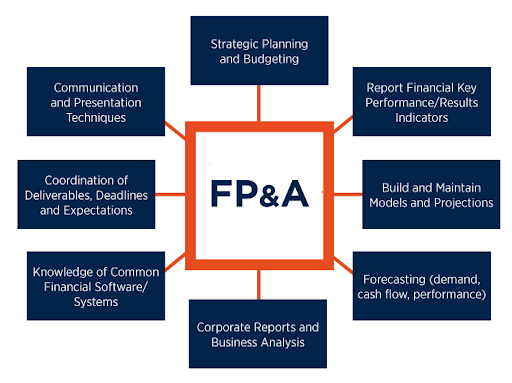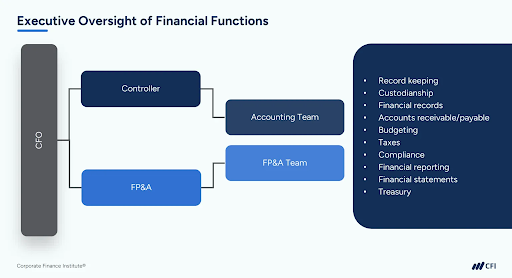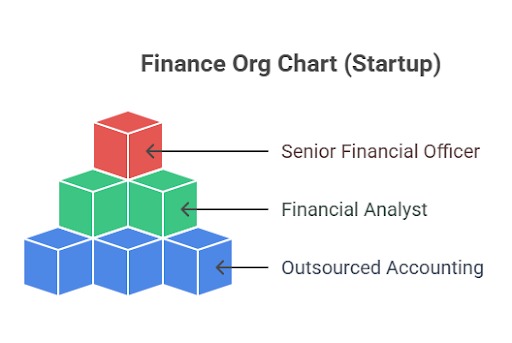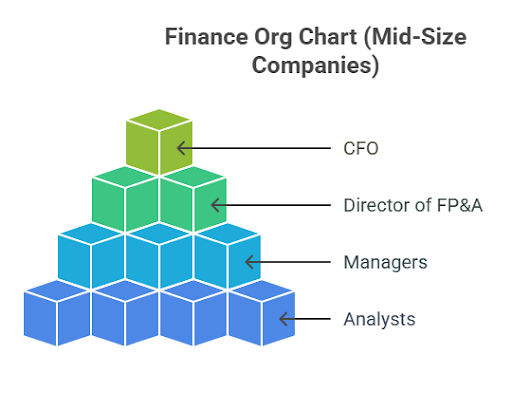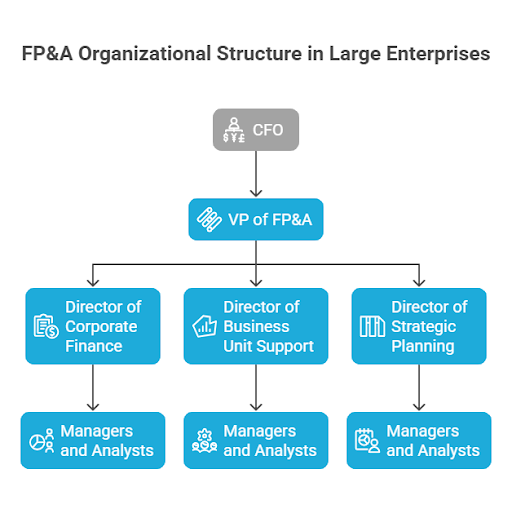How to Build an A+ FP&A or Finance Team That Delivers Results
Financial Planning and Analysis (FP&A) teams have evolved from traditional budgeting roles to strategic partners driving organizational success.
Their actionable insights are shaping how executive teams steer growth, manage risk, and allocate capital..
In fact, in a PwC survey, 58% of Chief Finance Officers (CFO) reported spending more time on FP&A because the value is undeniable.
To unlock that value, you need a high-performing FP&A and finance team built for modern financial planning.
In this article, you’ll learn how to hire finance talent for FP&A roles, which team structure to use, and how to empower them.
The Importance of FP&A Teams
The FP&A team acts like the financial compass and roadmap for a business. While traditional accounting looks backward to report what has already happened financially, FP&A looks forward and helps a company understand where it's going and how to get there.
They're not just number crunchers; they are strategic partners who provide insights that power crucial business decisions. They also ensure that a company's financial strategy aligns with its long-term goals. That ultimately translates into optimized resource allocation and better investor confidence.
“The FP&A function is evolving into an essential strategic framework for both finance leaders and decision-makers within businesses more broadly. In fact, FP&A helps to manage the value of the entire organisation. Its potential to do this comes from its unique ability to find the key drivers of success and influence the relevant stakeholders to make the right moves,” says Larysa Melnychuk, Founder and CEO of FP&A Trends
One of the core functions of an FP&A team is budgeting and forecasting. They work with all departments to create realistic budgets, estimating future revenues and expenses. Moreover, they develop forecasts, which are updated predictions of financial performance throughout the year, taking into account new information and market changes.
Beyond simply predicting numbers, FP&A teams play a vital role in strategic decision-making and risk management.
They analyze financial data to identify trends, spot potential risks, and uncover opportunities for growth and profitability. They help leadership evaluate investment opportunities, understand the financial implications of different business strategies, and make data-driven choices.
And with the rise of data visualization, their influence is growing. A Deloitte study found that 70% of CFOs reported faster, higher-quality decisions due to improved FP&A analytics tools.
What Does an A+ Finance Team Look Like?
According to McKinsey, a good FP&A team or a "next-level FP&A team" has the following characteristics:
Speed: They work faster, using new technologies like Artificial Intelligence (AI)-based software platforms to generate reports in real-time.
Data-driven: They rely more on data by building and managing data lakes or warehouses containing both financial and non-financial information. This makes it easy for CFOs to use and quote data when needed.
Strategic perspective: They develop a detailed understanding of strategy by identifying critical business factors and linking them directly to financial performance. They don’t just present and convince the leadership of big financial moves, but also provide detailed direction on how to go about it.
Trusted partners: They position themselves as trusted partners to business units and enable those units to make bold moves and improve overall performance.
Adaptability: They are able to adapt to increasing economic volatility and the growing volume of business data by using new technologies, data sources, and reporting processes.
What Skills to Look for in Finance Hires for Your FP&A Team?
Building a high-performing FP&A team requires a blend of technical proficiency, analytical acumen, and interpersonal capabilities. The exact skills might differ depending on the exact FP&A role.
Let’s explore some must-have technical and soft skills you must look for when hiring personnel for various FP&A roles:
Essential Technical Skills
Here are the hard skills required of FP&A teams:
Financial modeling and forecasting: Proficiency in creating financial models, like the ubiquitous three-statement model or the ARR snowball model for early-stage companies, is a must. These models serve as the basis for scenario planning and informed strategic decision-making.
Data analysis and visualization: Your FP&A team members, especially analysts, should be able to analyze complex datasets and present findings through business intelligence tools such as Tableau or Power BI. These skills enable finance professionals to transform raw data into actionable insights. After all, FP&A teams spend 45% of their time on data collection and validation.
Technological proficiency: Familiarity with enterprise performance management (EPM) or enterprise resource planning (ERP) tools and financial planning platforms, such as Adaptive Planning, is also important. These tools can be used for continuous planning and provide a single source of truth for financial data.
“Spreadsheets are an essential tool in analyzing that data, so FP&A employees need to be skilled with Microsoft Excel or a similar tool. They need to know the formulas and processes that will allow them to aggregate and manipulate raw data to produce key reports. They should know the basics of ERP systems, understanding how this software can automate reporting and assist with more complex reporting and analysis,” says Rami Ali, Senior Product Marketing Manager, Oracle NetSuite
Key Soft Skills
Although FP&A teams mostly crunch numbers, they should still possess some crucial soft skills:
Collaboration and communication: Effective communication skills are vital for FP&A professionals to convey complex financial information to non-finance stakeholders.
Strategic thinking: They should have a deep understanding of the business model and the ability to align financial planning with organizational goals. This involves identifying key drivers of financial performance and assessing future risks.
Adaptability and continuous learning: Given the convergence of technology and finance, FP&A individuals should continuously learn and adapt to new technologies and ways of doing things. In a survey, 83% of finance professionals said learning new competencies quickly is an essential soft skill.
FP&A Team Structures and Size
The structure and size of an FP&A team typically depend on a company’s growth stage, complexity, and strategic objectives. An effective FP&A team has enough numbers, again according to company size, to provide accurate insights and support strategic initiatives.
Here are some typical scenarios of FP&A and finance team sizes and structures:
Startups
In early-stage startups, financial planning processes are often managed by a single finance professional, such as a VP of Finance or CFO. They handle budgeting, forecasting, and financial modeling.
As the company grows, the team may expand to include a financial analyst to support these functions.
For example, at Aircall, a startup with 800 employees, the finance team comprises 20 individuals, with four dedicated to FP&A.
Enterprises
In larger organizations, FP&A teams are more structured and specialized. A typical enterprise FP&A team includes roles such as FP&A analysts, senior analysts, managers, and directors, each responsible for specific aspects of financial planning and analysis.
These teams often collaborate closely with business units to provide actionable insights and support strategic decision-making.
Role of the CFO in the FP&A team
The CFO generally oversees the FP&A function to ensure that financial planning aligns with the company's strategic goals. They might not be involved in the day-to-day operations and management of the FP&A team, especially in large organizations.
The CFO is responsible for high-level decision-making, risk management, and communicating financial performance to stakeholders. They rely on the FP&A team to provide accurate financial models, forecasts, and analyses that inform these decisions.
It wouldn’t be wrong to say that FP&A teams and their work are incredibly important for the CFO to do their job.
P.S. Looking to strengthen your FP&A capabilities without the overhead of a full-time hire? Explore our list of the Top 14 Fractional CFO Consulting Firms to find partners who deliver senior-level financial insight when it matters most.
Where to Find Finance Talent?
You can look for finance professionals on job boards, LinkedIn, or source niche talent via recruitment agencies.
Hiring skilled finance professionals has become quite a challenge. According to Robert Half, 87% of hiring managers report difficulty finding qualified candidates for finance and accounting roles, with nearly half (46%) specifically struggling to fill FP&A positions.
This challenge shows the limits of traditional hiring channels like job boards and LinkedIn. If you're building a high-performing finance team, consider these more targeted strategies:
Specialized job boards: Platforms like eFinancialCareers and the Financial Planning Association (FPA) Job Board offer access to a pool of finance professionals. These sites allow employers to post job openings and search for candidates with specific skills in financial analysis, budgeting, and forecasting.
Recruitment agencies: Work with recruitment firms that specialize in finance and accounting staffing. They provide access to candidates with experience in financial modeling, scenario planning, and strategic planning.
Pro Tip: Consider hiring remote finance professionals and FP&A analysts if you can’t find the talent locally. Most of their job is performed with computers, so you can hire analysts from anywhere in the world.
When to Hire Your First FP&A Lead (And What to Look For)?
Hire your first FP&A lead when your startup reaches early growth stages, typically post-Series A or B funding. At this point, financial complexity escalates, and you need dedicated budgeting, forecasting, and strategic planning oversight.
An ideal candidate should have a strong financial modeling, scenario planning, and risk management foundation. They should have proficiency in Excel or Google Sheets and ideally a more advanced financial analysis tool (at least the ones you plan to use).
Additionally, look for experience with financial planning processes and a track record of providing actionable insights to senior leaders.
For instance, a startup called PartsTech recognized the need for a strategic finance leader when it got investment from OpenView, a venture capital firm. They hired a CFO with a background in private equity and FP&A to guide its financial strategy.
How to Build the Most Efficient FP&A Team?
Consider the following steps to construct a winning FP&A team for your organization:
1. Define the Role of FP&A in Your Organization
A good FP&A team transcends traditional budgeting tasks and plays a crucial role in business partnering, forecasting, and strategic planning. For startups, that may be even more relevant because they typically require people to play interdisciplinary roles.
So, the first step is to define exactly what you want your FP&A team to achieve.
2. Identify the Core Roles You Need
A high-performing FP&A team involves key roles with various responsibilities:
FP&A analyst handles data consolidation, financial modeling, and supports budgeting and forecasting activities.
Senior financial analyst focuses on advanced financial analysis, scenario planning, and provides insights to support strategic decisions.
FP&A manager oversees the FP&A function, ensuring timely and accurate financial reports, and collaborates with other departments to align financial planning with business objectives.
Director/Head of FP&A leads the FP&A team, sets strategic direction, and communicates financial insights to senior leadership.
Business unit finance partner acts as a liaison between the FP&A team and specific business units, ensuring financial strategies align with operational goals.
Additionally, incorporating roles such as FP&A data scientists and architects can enhance the team's capabilities in data analysis and financial modeling.
Remember, while all these roles are important, not every organization (startups especially) may need to fill all of them. Decide exactly which roles can cover the current FP&A requirements for your company and go from there. As discussed earlier, for an early-stage startup, that could mean just a dedicated financial analyst.
Of course, you’d need a CFO heading the FP&A team. If you don’t yet have a finance executive, use a recruiter or headhunter for CFOs.
3. Build a Scalable Org Structure
A scalable FP&A organization balances centralized oversight with decentralized execution. Centralized teams maintain consistency in financial planning processes. On the other hand, decentralized teams are embedded within business units to provide tailored financial insights.
As your business grows, consider creating pods aligned with business units or geographies to ensure agility and responsiveness.
Similarly, add support roles like FP&A systems analysts and data engineers to support data management.
4. Invest in Tools and Infrastructure to Empower the Team
If you want your FP&A team to go from just crunching numbers to being real strategic MVPs, it's time to upgrade their toolkit. Spreadsheets alone just don't cut it anymore.
Modern financial planning needs smart, cloud-based platforms that can automate data collection, bring together info from different sources, and deliver real-time insights.
Invest in AI-powered forecasting, dynamic dashboards, and scenario modeling technologies. With these, your finance team can spend less time wrestling with data and more time spotting trends, offering insights, and helping steer the company in the right direction.
And here's a solid reason to make the switch: companies using cloud-based FP&A tools see a 20–30% boost in forecast accuracy compared to those sticking with spreadsheets.
5. Create a Culture of Insight and Partnership
Promote a culture where the FP&A team acts as a strategic partner rather than a compliance function. Encourage proactive reporting and regular cross-functional alignment to integrate these individuals into decision-making processes.
Pro tip: Regularly assess your team's strengths and preferences. Understand individual work styles and adjust roles and tasks accordingly. That will improve engagement and productivity by a long shot.
6. Invest in Training and Development
Continuous professional development for your finance team will only work out in your company’s favor.
Consider upskilling your team in data tools, storytelling, and business strategy to increase their capabilities further. Also, initiate workshops for cross-training with other departments for a better and broader understanding of the business.
Certifications are always a good idea. For instance, certifications like Certified Corporate FP&A Professional can help validate expertise and commitment to the field.
How to Benchmark Your FP&A Team’s Performance?
Benchmarking FP&A performance involves tracking key performance indicators (KPIs) that reflect both the efficiency and strategic impact of the FP&A function. As a Chief Executive Officer (CEO) or founder, you want to know how your finance and FP&A teams are doing, and these KPIs will help you do exactly that.
Some key FP&A KPIs to monitor are:
Forecast accuracy: This measures the precision of financial forecasts compared to actual results. For revenue or gross margin, this should ideally be within a 5-10% range.
Budget variance: Assesses the difference between budgeted and actual figures. That will highlight areas where financial performance deviates from expectations.
Scenario planning effectiveness: Evaluates the FP&A team's ability to model and analyze various business scenarios for agile planning and informed decision-making.
Stakeholder satisfaction: Another effective way to gauge the FP&A team's success in meeting the informational needs of key decision makers is through a stakeholder survey. High satisfaction levels reflect the team's ability to provide actionable insights and support strategic planning.
Timeliness of reporting: Monitor the speed at which financial reports are generated and disseminated. This is crucial for a quick insight-to-decision turnaround, which is particularly important in high-stakes situations.
Real Org Charts: Sample FP&A Team Structures by Stage
Here are some org charts to help you understand the structure and size of your potential FP&A/finance team:
Early-stage startups (Seed to Series A)
At this stage, financial planning is typically managed by a senior-level individual contributor, such as a VP of Finance or CFO (or even a fractional CFO), who handles budgeting, forecasting, and financial modeling.
This individual will collaborate with outsourced accounting services to manage financial statements and compliance. As the company grows, hiring a financial analyst to support these functions becomes essential.
Mid-sized companies (Series B to Pre-IPO)
As companies scale, the complexity of financial operations increases. A typical mid-sized company might have a finance team led by a CFO, with a Director of FP&A overseeing a team of managers and analysts. This structure supports more sophisticated financial planning processes, including scenario planning and strategic initiatives.
Enterprises (Post-IPO and beyond)
In large enterprises, the FP&A function may be organized by business unit, region, or function. The CFO oversees the entire finance organization, with a VP of FP&A managing multiple directors responsible for various areas, including corporate finance, business unit support, and strategic planning.
Each director leads a team of managers and analysts focused on specific aspects of financial planning and analysis.
Create the Best Finance Teams!
Many finance teams struggle not because of a lack of tools, but because of unclear roles, misaligned incentives, and poor communication. This creates a cycle of reactivity, missed forecasts, and burnout that stalls both their careers and the company's growth.
You can avoid that by creating a high-performing finance/FP&A team that takes pride in its job, uses the latest technologies, and guides your organization to financial success.
A good FP&A team is particularly valuable for companies with high operating costs, as sound financial budgeting and forecasting can help increase revenue and profit margins.
If you're scaling your business and ready to level up your finance function, explore the Top Fractional CFO Consulting Firms that can help you build a finance team with real strategic impact.
Frequently Asked Questions (FAQs)
What is FP&A?
Financial Planning and Analysis (FP&A) is crucial to financial operations. It involves budgeting, forecasting, and financial analysis to support strategic decision-making within an organization. FP&A teams provide accurate insights into financial performance, which business leaders use to make informed, data-driven decisions.
What are the tasks of an FP&A team?
An FP&A team is responsible for various activities, including developing financial models, conducting scenario planning, and preparing financial reports. They analyze financial statements to assess the company’s financial position and support strategic initiatives by providing actionable insights. In mid- to large-sized organizations, FP&A teams also collaborate with other departments to ensure that financial planning aligns with operational goals.
What qualifications should a financial analyst have?
A financial analyst typically holds a bachelor's degree in finance, accounting, or a related field. They may also have certifications, such as the Chartered Financial Analyst (CFA), but these are usually not mandatory.
How to structure an FP&A team?
Structuring an FP&A team involves defining clear roles and responsibilities to support the organization's financial planning processes. A typical hierarchy includes FP&A analysts, senior analysts, managers, and directors, each contributing to different financial analysis and planning aspects.
The structure of your FP&A team will depend on your company's size, complexity, resources, and requirements.
How big should the FP&A team be?
The size of an FP&A team should be based on your organization's scale and financial complexity. For instance, a company with $15 billion in revenue might have an FP&A team comprising 20-25 professionals, including analysts, managers, and directors. Smaller companies can easily operate with leaner teams, focusing on core financial planning activities. Startups can make do with one or two financial analysts.
What is the hierarchy of FP&A roles?
The FP&A hierarchy typically progresses from analysts to senior analysts, followed by managers, directors, and ultimately the Vice President (VP) of FP&A in large enterprises.
Each level entails increasing responsibility, from conducting financial analyses to overseeing strategic planning and guiding the organization's financial direction.

